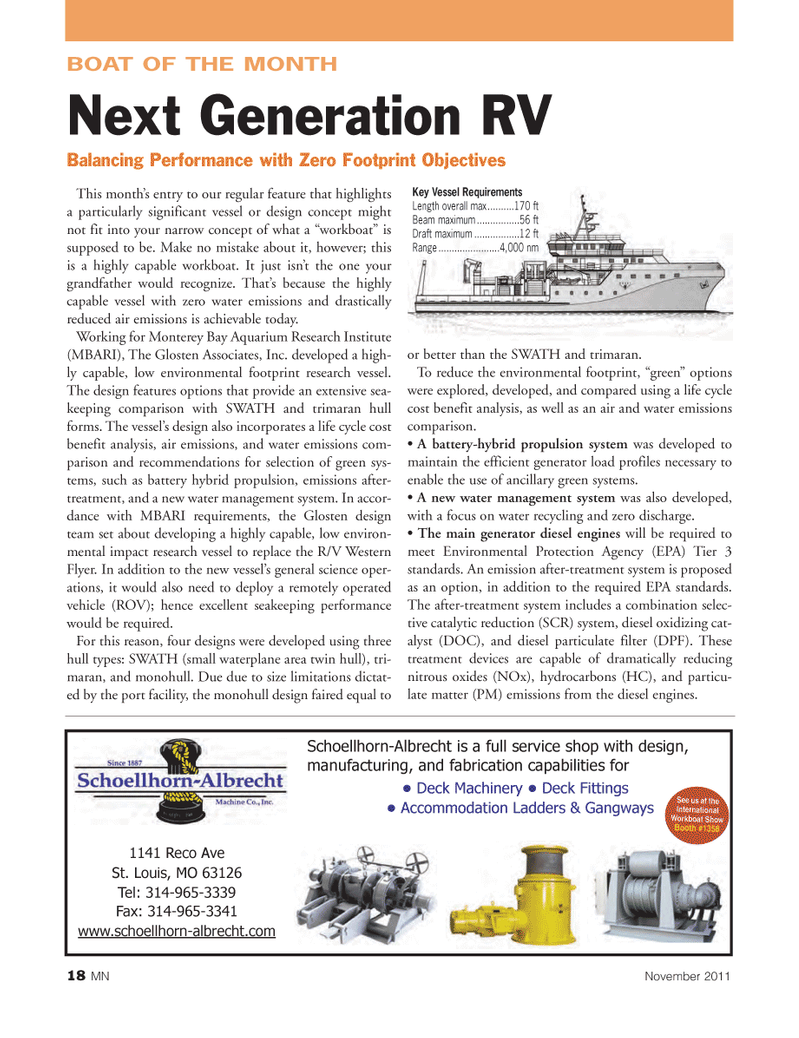
Page 18: of Marine News Magazine (November 2011)
Workboat Annual
Read this page in Pdf, Flash or Html5 edition of November 2011 Marine News Magazine
18MNNovember 2011Schoellhorn-Albrecht is a full service shop with design, manufacturing, and fabrication capabilities for ?Deck Machinery ?Deck Fittings ?Accommodation Ladders & Gangways 1141 Reco Ave St. Louis, MO 63126Tel: 314-965-3339 Fax: 314-965-3341 www.schoellhorn-albrecht.com Seeusatthe International Workboat Sho wBooth #1358BOAT OF THE MONTH This month?s entry to our regular feature that highlights a particularly significant vessel or design concept might not fit into your narrow concept of what a ?workboat? is supposed to be. Make no mistake about it, however; this is a highly capable workboat. It just isn?t the one your grandfather would recognize. That?s because the highly capable vessel with zero water emissions and drastically reduced air emissions is achievable today. Working for Monterey Bay Aquarium Research Institute (MBARI), The Glosten Associates, Inc. developed a high- ly capable, low environmental footprint research vessel. The design features options that provide an extensive sea- keeping comparison with SWATH and trimaran hull forms. The vessel?s design also incorporates a life cycle cost benefit analysis, air emissions, and water emissions com-parison and recommendations for selection of green sys- tems, such as battery hybrid propulsion, emissions after- treatment, and a new water management system. In accor- dance with MBARI requirements, the Glosten design team set about developing a highly capable, low environ- mental impact research vessel to replace the R/V Western Flyer. In addition to the new vessel?s general science oper- ations, it would also need to deploy a remotely operated vehicle (ROV); hence excellent seakeeping performance would be required. For this reason, four designs were developed using three hull types: SWATH (small waterplane area twin hull), tri- maran, and monohull. Due due to size limitations dictat- ed by the port facility, the monohull design faired equal to or better than the SWATH and trimaran. To reduce the environmental footprint, ?green? options were explored, developed, and compared using a life cycle cost benefit analysis, as well as an air and water emissions comparison. A battery-hybrid propulsion system was developed to maintain the efficient generator load profiles necessary to enable the use of ancillary green systems. A new water management system was also developed, with a focus on water recycling and zero discharge. The main generator diesel engines will be required to meet Environmental Protection Agency (EPA) Tier 3 standards. An emission after-treatment system is proposed as an option, in addition to the required EPA standards. The after-treatment system includes a combination selec- tive catalytic reduction (SCR) system, diesel oxidizing cat- alyst (DOC), and diesel particulate filter (DPF). These treatment devices are capable of dramatically reducing nitrous oxides (NOx), hydrocarbons (HC), and particu- late matter (PM) emissions from the diesel engines. Key Vessel Requirements Length overall max..........170 ft Beam maximum................56 ft Draft maximum.................12 ft Range.......................4,000 nm Next Generation RV Balancing Performance with Zero Footprint Objectives MN#11 (18-31):MN 2011 Layouts 10/28/2011 3:40 PM Page 18

 17
17

 19
19
